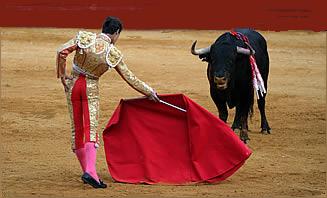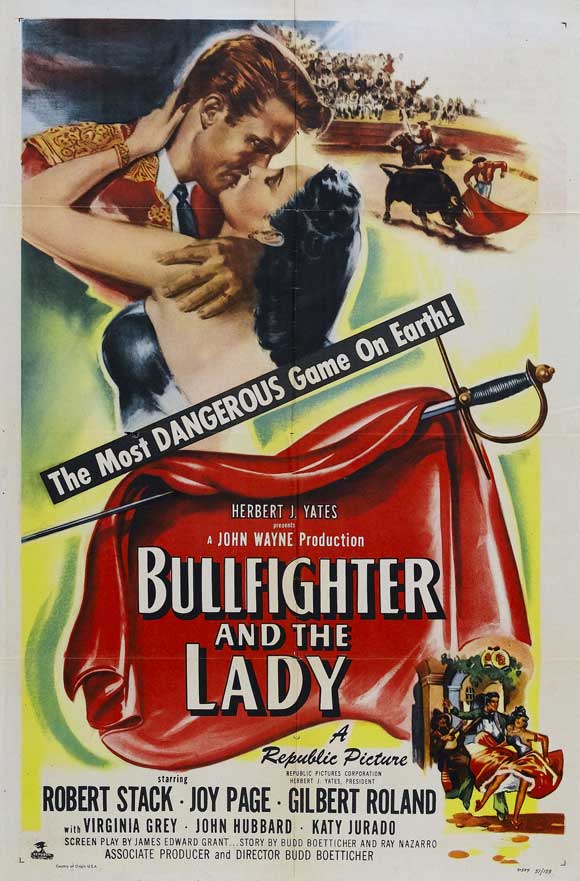You've got to ask yourself one question...
Do I feel lucky?
Well do you, punk?
Origins of Bullfighting in Spain
Bullfighting originated in Spain in 711 AD with King Alfons VIII. Since then the sport of dodging death has become a staple to the nation of Spain. Bullfighting venues can be found throughout the entire nation and venues exist in nearly every town.
Bullfighting advertisements through time
 Noted American novelist Ernest Hemingway was one of the first individuals to popularize bullfighting on an international stage. After spending ample amounts of time in Pamplona, he became obsessed with the sport. As a result of his findings in Spain, Hemingway published two books on the subject matter. The first was entitled "The Sun also Rises" printed in 1926. The second one followed in 1932 and was called "A Death in the Afternoon" (Seville Traveller)
Noted American novelist Ernest Hemingway was one of the first individuals to popularize bullfighting on an international stage. After spending ample amounts of time in Pamplona, he became obsessed with the sport. As a result of his findings in Spain, Hemingway published two books on the subject matter. The first was entitled "The Sun also Rises" printed in 1926. The second one followed in 1932 and was called "A Death in the Afternoon" (Seville Traveller)This print ad is an example of a local advertisement posted in the Spanish town several weeks leading up to the event as a way to inform the public about the fight (Miller).
"Bullfighter and the Lady" was one of the first American written films about Spanish bullfighting. The screenplay written by James Edward Grant was released in 1951. The plot focuses on the sport and dangers of bullfighting intertwined with a love story (Growther).
The Event
The bullfighting season lasts from February to mid-October. Depending on the venue and who is performing, tickets can cost anywhere from five euros to 150 euros. Seating is determined by sun and shade, oddly enough. Lower seats in the shade are the most expensive while higher seats in the sun are less expensive (Seville Traveller).
Outside of the Arena
People from all over the world experience the culture of Spain within the confines for the bullfighting ring. Ironically enough, the most notorious bullfighting event that Spain has to offer takes place outside of the arena in the streets of Pamplona, Spain.
Pamplona is home to the notorious "Running of the Bulls." The dangerous tradition, whose roots date back to 1385, occurs every year in early July as a test of man versus beast. Live bulls are released into the streets as people run for the lives (literally) away from them. Since 1926, 14 fatalities have occurred with the last one happening in 2009 to a 27-year old Spaniard male who was gored to death. While this action seems absolutely crazy, it has become an international phenomenon and draws crowds of hundreds of thousands of people (The Week).
There's an app for that
 In keeping up with the times, a smart phone application has been developed by the Pamplona City Council called Bull Run Trainer. Its content features advice on how to survive the run along with statistics from past years (The Week).
In keeping up with the times, a smart phone application has been developed by the Pamplona City Council called Bull Run Trainer. Its content features advice on how to survive the run along with statistics from past years (The Week). Running of the Bulls- Dewey Beach
Running of the Bulls is so well known that naturally other places around the world want to steal the thunder and emulate this great festival. Then again, who is crazy enough to release wild bulls into the street to terrorize the public.
My hometown of Dewey Beach, Delaware found a happy medium where they were able to re-create the Running of the Bulls but in a safer environment. Below is the link to Delaware's mock Running of the Bulls (click on the youtube video in the article).
References
Growther, B.
(1951, April 27). Bullfighter and the
Lady. Retrieved October 23, 2011 from
http://movies.nytimes.com/movie/review?res=9F03E0DC1F3EEF3BBC4F51DFB266838A649EDE
Miller, T.T.
(2004). The Tip of the Horn.
Retrieved October 23, 2011 from http://www.lostgeneration.com/article7.htm
Seville
Traveller. (2011). How to Buy Bullfight
Tickets. Retrieved October 23, 2011 from http://www.seville-traveller.com/bullfight-tickets.html
The Week.
(2011, July 6). Spain’s Running of the
Bulls: 7 Curious Facts. Retrieved October 23, 2011 from
http://theweek.com/article/index/216929/spains-running-of-the-bulls-7-curious-facts








No comments:
Post a Comment